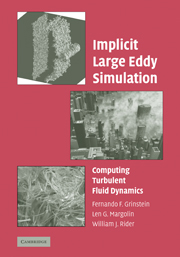Book contents
- Frontmatter
- Contents
- Preface
- List of Acronyms
- List of Contributors
- Introduction
- SECTION A MOTIVATION
- SECTION B CAPTURING PHYSICS WITH NUMERICS
- SECTION C VERIFICATION AND VALIDATION
- 7 Simulating Compressible Turbulent Flow with PPM
- 8 Vortex Dynamics and Transition to Turbulence in Free Shear Flows
- 9 Symmetry Bifurcation and Instabilities
- 10 Incompressible Wall-Bounded Flows
- 11 Compressible Turbulent Shear Flows
- 12 Turbulent Flow Simulations Using Vorticity Confinement
- 13 Rayleigh–Taylor and Richtmyer–Meshkov Mixing
- SECTION D FRONTIER FLOWS
- Index
- Plate section
13 - Rayleigh–Taylor and Richtmyer–Meshkov Mixing
from SECTION C - VERIFICATION AND VALIDATION
Published online by Cambridge University Press: 08 January 2010
- Frontmatter
- Contents
- Preface
- List of Acronyms
- List of Contributors
- Introduction
- SECTION A MOTIVATION
- SECTION B CAPTURING PHYSICS WITH NUMERICS
- SECTION C VERIFICATION AND VALIDATION
- 7 Simulating Compressible Turbulent Flow with PPM
- 8 Vortex Dynamics and Transition to Turbulence in Free Shear Flows
- 9 Symmetry Bifurcation and Instabilities
- 10 Incompressible Wall-Bounded Flows
- 11 Compressible Turbulent Shear Flows
- 12 Turbulent Flow Simulations Using Vorticity Confinement
- 13 Rayleigh–Taylor and Richtmyer–Meshkov Mixing
- SECTION D FRONTIER FLOWS
- Index
- Plate section
Summary
Introduction
Rayleigh–Taylor (RT) instability (see Sharp 1984) occurs when the interface between two fluids of different density is subjected to a normal pressure gradient with a direction such that the pressure is higher in the less dense fluid. The related Richtmyer–Meshkov (RM) process (see Holmes et al. 1999) occurs when a shock wave passes through a perturbed interface. These instabilities are currently of concern for researchers involved in inertial confinement fusion (ICF). RT and RM instabilities can degrade the performance of ICF capsules, where high-density shells are decelerated by lower-density thermonuclear fuel. In these applications and in many RT or RM laboratory experiments, the Reynolds number is very high. Turbulent mixing will then occur. Direct numerical simulation (DNS) is feasible at a moderate Reynolds number. However, for most experimental situations, the calculation of the evolution of turbulent mixing requires some form of large eddy simulation (LES).
The flows of interest here involve shocks and density discontinuities. It is then highly desirable to use monotonic or total variation diminishing (TVD) numerical methods, either for calculating the mean flow or the development of instabilities. Hence, for three-dimensional turbulent flows, monotone-integrated LES (MILES) is very strongly favored.
My purpose in this chapter is to show that a particular form of MILES gives good results for RT and RM mixing. I consider the mixing of miscible fluids, and I assume the Reynolds number to be high enough for the effect of the Schmidt number to be unimportant.
Information
- Type
- Chapter
- Information
- Implicit Large Eddy SimulationComputing Turbulent Fluid Dynamics, pp. 392 - 410Publisher: Cambridge University PressPrint publication year: 2007
Accessibility standard: Unknown
Why this information is here
This section outlines the accessibility features of this content - including support for screen readers, full keyboard navigation and high-contrast display options. This may not be relevant for you.Accessibility Information
- 6
- Cited by
